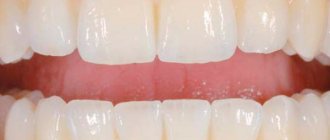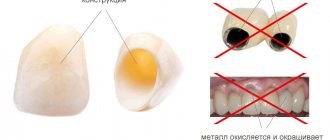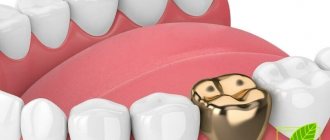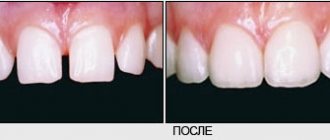Content:
- Why are temporary fillings placed?
- Why use it - indications for use
- How long can you walk with such protection?
- Manufacturing materials
- How does the installation work?
- Rules of care
- If the coating collapses prematurely
- How does the replacement work?
Often, patients at dental clinics are faced with a situation where the doctor gives them a cheap intermediate filling and indicates the day when they need to come back for a follow-up appointment to replace it with a permanent one. We suggest you understand this treatment tactics and its features.
Diagnosis and treatment planning
During the consultation, the orthopedic dentist listened to the patient’s complaints and conducted an examination. There are old massive fillings on the chewing teeth of the upper and lower jaw. Due to the expiration of their service life, as well as under the influence of stress, the fillings began to break down, chips appeared, which is why the teeth under the fillings are not sealed tightly, and caries develops under the fillings.
Orthopedic dentist proposed a treatment plan
:
- Removal of old fillings and treatment of caries (if necessary, treatment of tooth canals with a microscope);
- Preparation of teeth for prosthetics with ceramic crowns and installation of temporary crowns;
- Fixation of permanent ceramic crowns on chewing teeth.
When asked: which crowns are best to install on teeth, Dial-Dent specialists advise choosing ceramic crowns. Modern ceramic crowns are durable and aesthetic. Ceramic crowns on teeth do not have a negative effect on the gums, are biologically neutral, and do not cause allergies.
The patient is warned that, if necessary, it will be necessary to treat the canals of some teeth, since caries in the teeth under fillings can be deep. If possible, teeth under crowns will remain alive, as this will preserve the strength of the teeth and the health of the jaw bone tissue.
An estimate for treatment was drawn up indicating the cost of all stages of treatment and dental prosthetics.
Why are temporary fillings placed?
They are intended for:
- protecting the damaged dental area from the destructive influence of pathogens;
- preventing the accumulation of food debris in the carious “hollow”;
- reliable fixation of the applied medicinal mixture.
Under the filling material there is always a special medicine that treats the unit from the inside, or a paste that kills the nerve. It turns out that a non-permanent filling is indicated in cases where multi-stage therapy is carried out.
Why use it - indications for use
Dentists install temporary filling compounds for:
- Advanced caries. If the cavity is very deep, after it has been cleansed of the affected tissue, a medicinal solution is applied to make the layer between the open area of the crown and the dentin as strong as possible.
- Progressive acute pulpitis. Requires depulpation. For this purpose, a medicine is placed into the “hole” that destroys the nerve. It is covered with a protective insulating compound, which will be replaced in the future.
- Periodontitis. With this disease, progressive inflammation in the root area is observed. To stop it, the dentist puts an antiseptic medicine inside the canals. To securely fix it, a hardening gel is placed on top.
- Complicated carious process. Sometimes dentists are faced with a non-standard course of a diagnosed disease. Then, in order to select an effective treatment, they decide to observe the dynamics. In this case, there is no point in installing a permanent element - it will most likely have to be removed soon. Therefore, preference is given to the temporary.
- Manufacturing of dental crowns and bridges. After impressions are taken, it is important to protect the sawn parts of the unit. To do this, use a temporary filling or crown.
Sometimes non-permanent filling is used during the sanitation of dental canals. This is necessary to prevent recurrence of the treated disease. The specialist thoroughly cleans all intradental areas, then applies an antiseptic and closes it on top for a certain period of time. During repeated appointments, he uses permanent hardening mixtures.
Treatment of caries and root canal treatment with a microscope
It is known that the best dental prosthetics are those that preserve the health of teeth and gums for many years, and improve the patient’s quality of life. At Dial-Dent, we carefully approach dental treatment before prosthetics - treatment of dental caries under fillings is carried out with a microscope in order to remove absolutely all affected tissue and not give caries a chance to develop further.
The treatment of caries and the treatment of tooth canals with a microscope was carried out by an endodontist. The work of an endodontist ensures that the tooth under the crown will not be disturbed. Cleaning and filling of dental canals with a microscope are carried out at a higher level.
In some teeth, under old fillings, a deep carious process was discovered with damage to the pulp (internal tissues of the tooth). These teeth underwent root canal treatment (in three teeth). In the remaining teeth, after removal of old fillings, caries treatment was carried out. All teeth were restored with fillings for subsequent prosthetics.
How long can you walk with such protection?
Compliance with the terms of wearing is a guarantee that nothing will happen to the tooth. If time is missed, the medicine placed inside the unit will begin to destroy its walls. It will also become leaky, which means that pathogenic microorganisms will begin to actively multiply in the resulting microgaps.
The exact wearing period depends on the characteristics of the material used and the dental diagnosis. The doctor calls him. If we are talking about a paste that destroys nerve tissue, then it is removed after 5-10 days. It happens that you have to repeat the procedure several times, but there is nothing to worry about. If the composition is placed inside the unit to stimulate regeneration processes, then therapy takes about two to three weeks.
Manufacturing materials
When choosing a composition for temporary closure of a carious cavity, the following are taken into account:
- size of the lesion;
- diagnosis;
- expected duration of treatment;
- the patient is allergic to medications.
Most often, doctors use the following intermediate-acting filling solutions:
- From kaolin and zinc sulfate. The mixture allows you to partially restore dentin - the hard crown part located under the enamel.
- Polycarboxylate. Low-toxic cement used to fix a crown, inlay or dental bridge. Can act as an insulating gasket when installing amalgam and cement elements.
- Karyosan. Zinc oxyeugenol cement, formed by zinc oxide and eugenol. Shows analgesic and antiseptic properties. Used to disinfect canals and relieve inflammation.
- Vinoxol. Includes zinc oxide and a solution of polystyrene in guaiacol. High-quality artificial dentin that can withstand chewing load for one to two months.
- Glass ionomer cement. Suitable if you need to fix dentures for a short period of time.
What materials to choose
In fact, what filling to put under the crown largely depends on the condition of the tooth and the treatment tactics chosen by the dentist. If the walls of the tooth are thin and fragile, and the doctor does not make an inlay for any medical reasons, it is better to use a light-curing filling material, or photopolymer. The photopolymer is very durable, practically does not shrink, and provides reliable adhesion to dental tissues. Its use in this case will help protect the tooth from the possible appearance of cracks and destruction of fragile walls, which means that the entire restoration will last longer and more reliably.
If dental posts will be installed in the root canals, it is better to use a composite material or glass ionomer cement around them. However, sometimes the doctor prefers to use photopolymer again.
In any case, the choice depends on the clinical situation, but the dentist will always be sympathetic to the patient’s wishes - unless, of course, they contradict medical reasons and do not worsen the outcome of the treatment.
How does the installation work?
Since the composition is intermediate and is laid down for a specific purpose, it is logical that its use is preceded by certain preparatory manipulations:
- The doctor cleans the affected area using a drill and medical instruments. He carefully removes the remnants of altered tissue to prevent further destruction of the crown.
- Then it processes the channels. There are two options here - either the nerve is removed immediately, followed by washing the roots with an antiseptic, or a medicinal mixture is applied.
- A filling is placed on top, which will soon be replaced.
- Before letting the patient go, the dentist tells you how to care for the tooth , when to come next time, and what to do if the mixture falls out prematurely.
Dental prosthetics with ceramic crowns
After dental treatment, the orthopedic dentist began preparing the teeth for prosthetics with ceramic crowns. To prepare living teeth for prosthetics, the doctor uses a special approach - the tooth is ground down slowly and carefully to prevent overheating of the tissue. An orthopedic dentist has to work longer, but the main thing here is that the patient’s health is preserved. To improve the quality of work, the dentist uses special optics.
When preparing teeth for crowns and installing crowns on teeth at Dial-Dent, isolation of the working area using a rubber dam is mandatory - this ensures high quality of preparation and fixation of crowns on teeth.
Ceramic crowns will be thin-walled, so there is no need to sharpen the teeth for crowns. The photographs show that the teeth are minimally ground.
The prepared teeth are covered with temporary crowns.
Thin-walled ceramic dental crowns are made from pressed E.max ceramics. Modern ceramics are not inferior in strength to metal-ceramics, and the cost of ceramic crowns has become more affordable, and hypoallergenicity and the absence of side effects put ceramics beyond competition, so Dial-Dent specialists believe that dental prosthetics with ceramics is the best dental prosthetics.
Ceramic crowns strengthened chewing teeth after treatment of extensive and deep caries and restored their functionality. The use of optical magnification by an orthopedic dentist makes it possible to achieve an ideal joint between the crown and the tooth (through careful polishing), which improves the quality of dental prosthetics.
Rules of care
A temporary “barrier” is less durable than a permanent one. He is able to cope with the chewing load for up to two to three weeks. If you "carry" it, it will collapse or fall out. In this regard, until the dentist replaces it with a permanent one, it is important to follow the following rules:
- Avoid eating too solid foods. Nuts, crackers, seeds, etc. are prohibited.
- Do not use chewing gum or sticky candies.
- Carry out hygienic cleaning twice a day - in the morning and in the evening after meals. Use only a brush with soft bristles.
- Do not use a paste containing abrasive particles during treatment.
- After each meal, hygienically rinse the mouth with warm water.
By keeping these rules in mind, you can significantly reduce the likelihood of destruction of the established composition.
If the coating collapses prematurely
It happens that one day a person notices that the carious cavity is left without protection. No need to panic. The fact that a diseased tooth is open to invasion by pathogenic microflora is bad, but it is easy to fix. You should immediately visit your dentist to have it refilled.
If for some reason it is impossible to do this, and the visit has to be postponed by several days, you should monitor the condition of the “hole” and ensure that food debris does not collect in it. See your doctor as soon as possible.
Under no circumstances should you close an open cavity with chewing gum, gauze, cotton wool or other improvised means. These measures will worsen the situation - they will increase the likelihood of infection entering the deep tissues of the tooth.
Arsenic in the tooth: what to do if it still hurts?
Arsenic in dentistry is used to reliably kill the diseased nerve of the tooth. This technique has long been known and is slowly giving way to modern methods of anesthesiology. However, modern specialists still often practice the use of arsenic.
Arsenic in the tooth: the tooth hurts, you need to block the pain
In diseases such as caries, pulpitis or periodontitis, the inflamed dental nerve causes severe pain. In order to “kill” the diseased nerve, a special arsenic paste is used, the dosage of which is calculated individually for each patient. After putting the paste into the affected tooth, the doctor sets the time for the next appointment, which cannot be postponed. You can walk around with arsenic in your tooth for no more than three days!
What to do if there is arsenic in the tooth, but the tooth still hurts?
As a rule, arsenic quite quickly carries out the process of necrotization of the pulp, and the tooth stops hurting. But it also happens that there is arsenic in the tooth, but it still hurts. Most often, the pain after placing a temporary filling with arsenic subsides gradually over one to two days. If, after this period, the tooth continues to hurt, this can be caused by various reasons:
- pain is your body's reaction to the drug;
- temporary filling has an irritating effect;
- the doctor has chosen the wrong dosage of the drug for you;
- the medicine was installed incorrectly;
- osteonecrosis has occurred;
- the inflammation process has gone beyond the pulp.
In any of the indicated cases, you should immediately consult a doctor, because tooth pain that does not stop after arsenic is present is a very alarming sign.
What to do as first aid before you visit the dentist?
In order to relieve pain, we advise you to take some anti-inflammatory non-steroidal drug. For example, diclofenac, nurofen, ibuprofen, etc. Ordinary analgin can also help. Do not self-medicate under any circumstances - do not rinse the sore tooth with warm solutions and do not apply heat to the sore spot. If the pain is unbearable, and there is still a long time before visiting a doctor, you can try to remove the medicine yourself, but under no circumstances swallow or chew it, and after removing it, rinse your mouth thoroughly.
You can get a consultation at the DENTISTRY clinic. Make an appointment by calling +7 (8342) 308–088 or using the form below.
Make an appointment
How does the replacement work?
When the medicine under the protective “barrier” stops working, a permanent filling is installed. Using a drill, the doctor removes the remaining temporary material. Then it carries out antiseptic treatment of the opened tissues. Makes sure there are no complications and then places the permanent material.
All manipulations are carried out in one visit to the doctor. They are usually comfortable and do not require the use of painkillers - after all, the inflammation has already been cured and the nerve has been removed.










